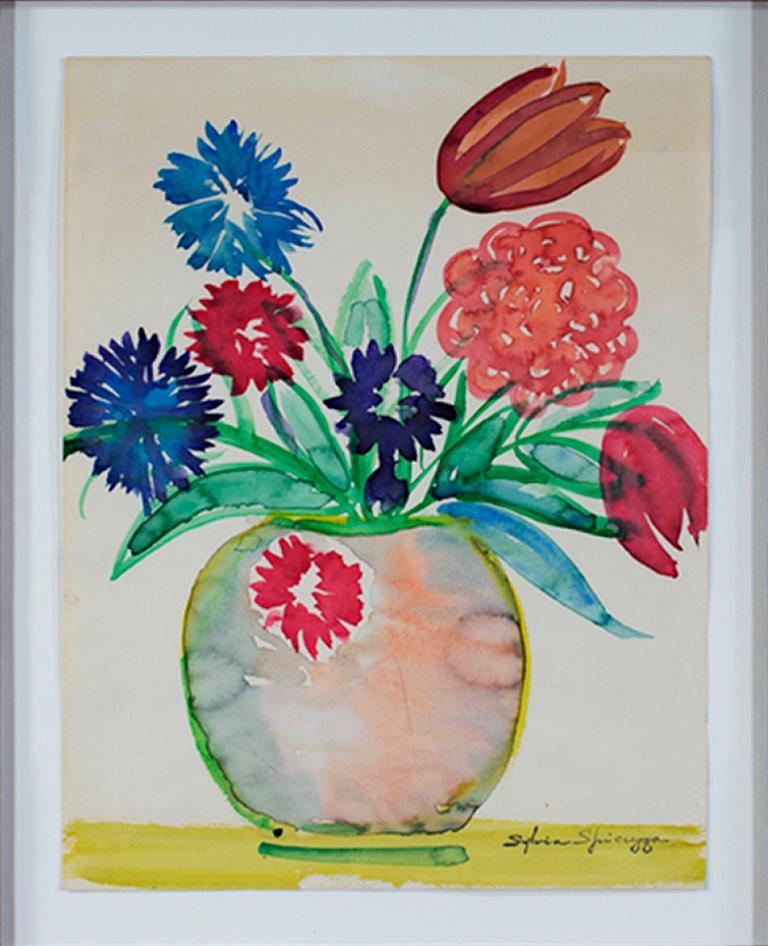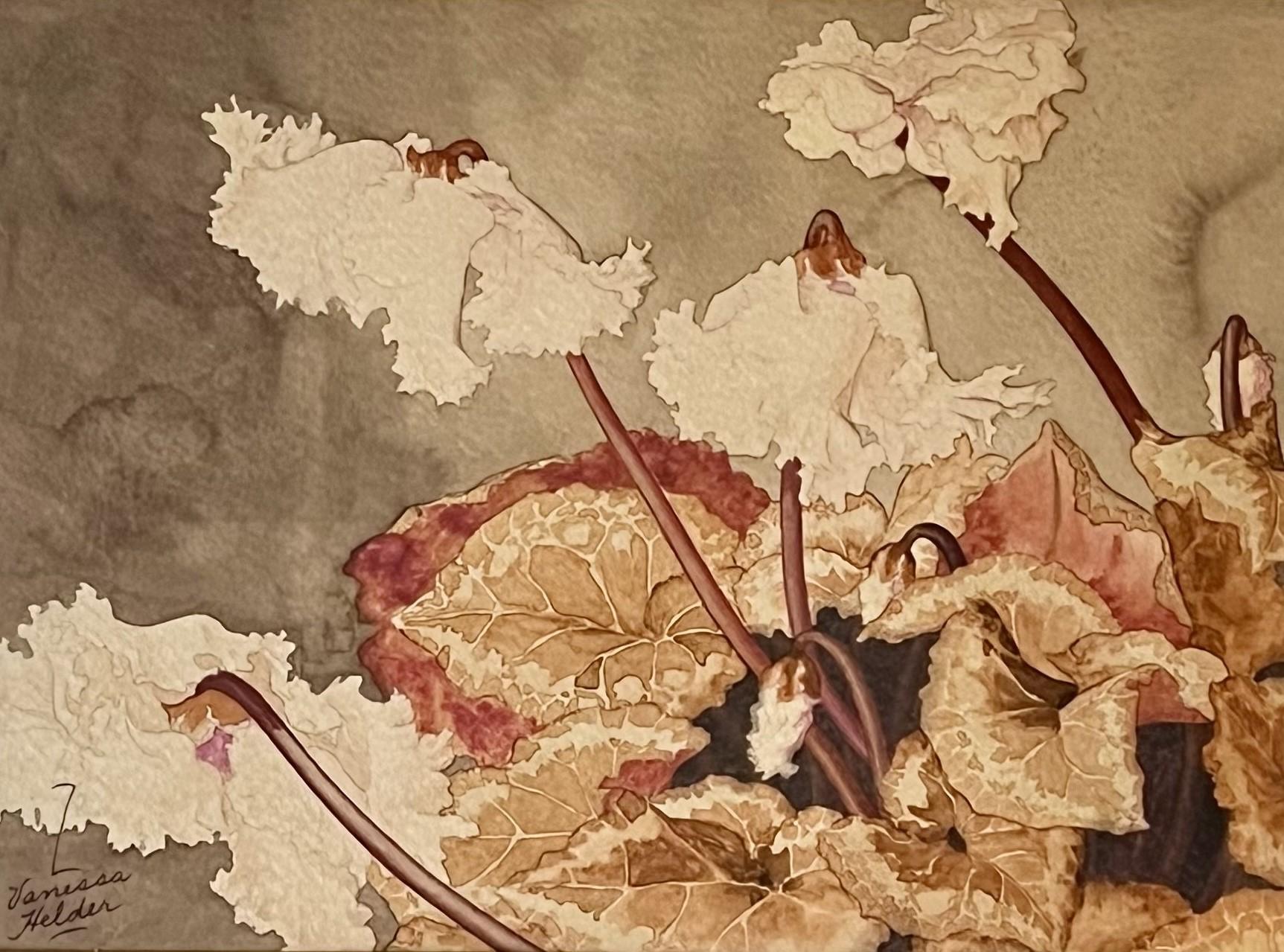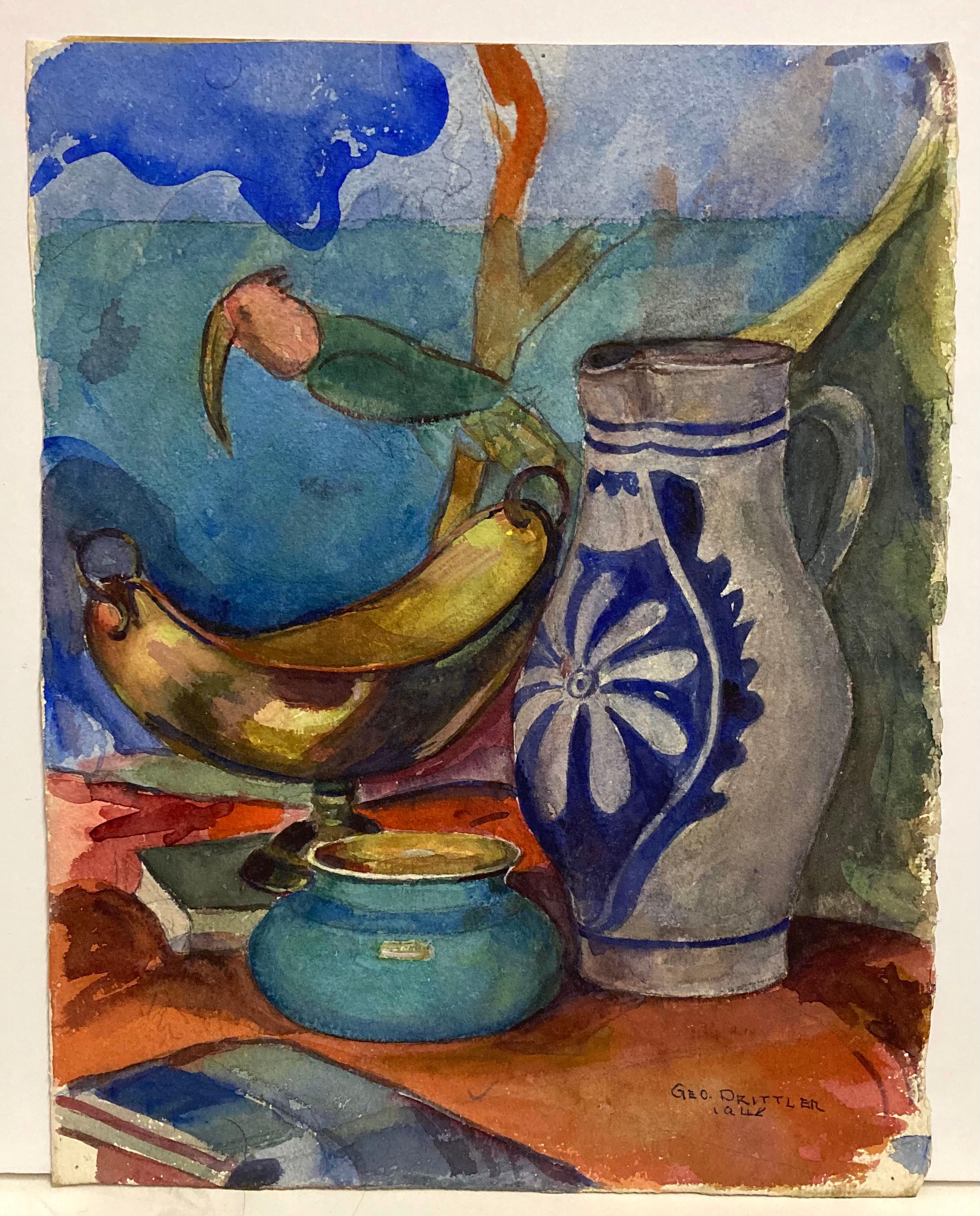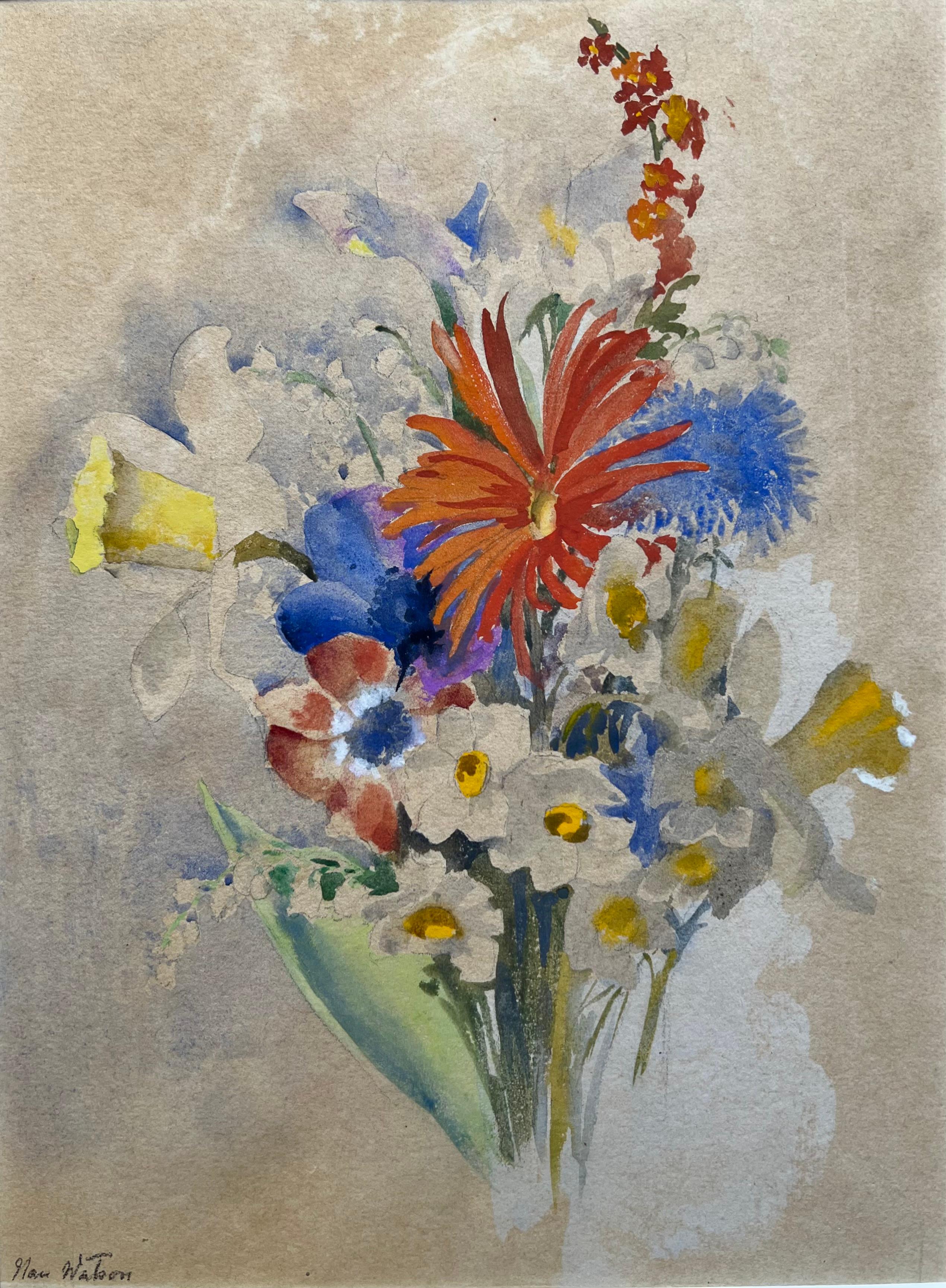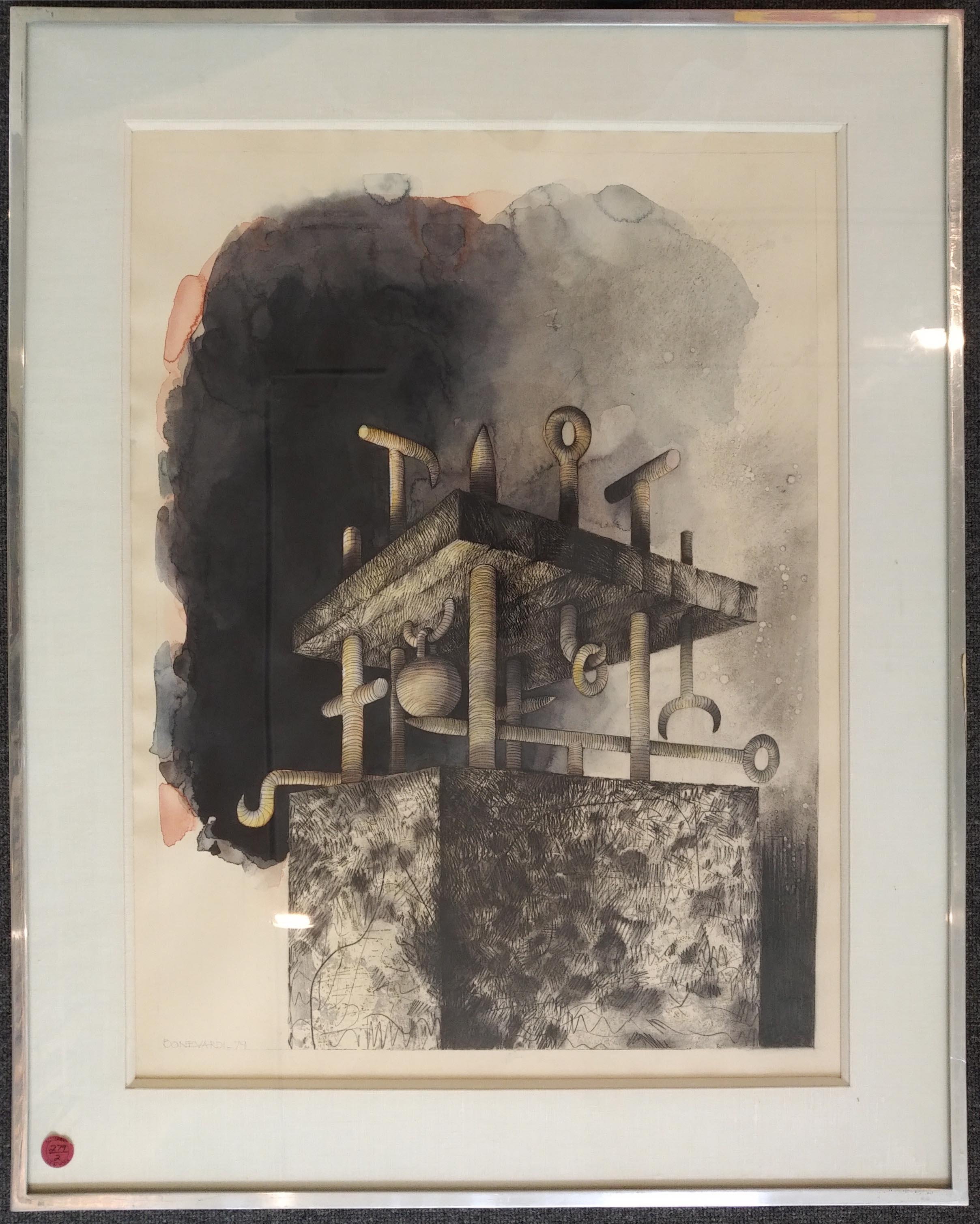Items Similar to Flowers Still Life
Want more images or videos?
Request additional images or videos from the seller
1 of 5
Edward Beatty RowanFlowers Still LifeCirca 1930s
Circa 1930s
About the Item
(Note: This work is part of our exhibition Connected by Creativity: WPA Era Works from the Collection of Leata and Edward Beatty Rowan)
Watercolor on paper, 20 ½ x 16 inches unframed sheet, 27 ½ x 21 inches framed, but not glazed, inscribed “550 – 514” verso
About the Artist:
Edward Beatty Rowan was among the most significant and innovative thought leaders of the American art scene during the Great Depression. As an arts administrator, teacher, artist, writer, lecturer, critic, and gallerist, he helped define the look and feel of American art from the late 1920s through World War II. Rowan was born in Chicago, Illinois on March 11, 1898. By 1910, Rowan and his family had moved to Hamilton, Ohio, approximately twenty miles north of Cincinnati. Rowan graduated from Hamilton High School, served in the United States Army during World War I, and was honorably discharged as a private on December 21, 1918. He then attended Miami University in nearby Oxford, Ohio, where he met his wife, Leata Mae Peer, and graduated in 1921. In the mid-1920s, Rowan received a scholarship to attend Harvard University where he received a master’s degree in fine art. Following his graduation from Harvard, the Rowans founded the Little Gallery in Cedar Rapids, Iowa, with support from the Carnegie Foundation and the American Federation of Arts.
From that point forward, Edward Rowan was at the center of America’s most significant art communities and associated with many of the nation’s most important artists of the Depression Era. His keen eye and efficient administration of public works projects produced a prodigious legacy of murals in hundreds of post offices and other public spaces across the country. Through his work with the American Federation of Arts, Rowan curated and organized traveling exhibitions of paintings, drawings, sculptures, and watercolors, which toured the country, reaching small communities and providing important sources of exposure and income for artists.
Rowan was a tireless worker whose passion was to promote craftsmanship and art education to the masses. He was one of the rare individuals to pursue his passions at all levels. Rowan participated in the grassroots movement of his Little Gallery in Cedar Rapids and the Stone City Art Colony and served in Washington, D.C. as the New Deal's Assistant Technical Director of the Public Works of Art Project (PWAP) and an administrator of the Federal Emergency Relief Administration (FERA). Rowan also served as Superintendent of the Treasury Department’s Section of Painting and Sculpture (“Section of Fine Arts” or “the Section”) where he was responsible for doling out millions of dollars of taxpayer funds to beautify government buildings. In these roles, he was able to help define a narrative that attempted to glorify what was thought to be uniquely American.
Rowan was also an artist, who honed his skills while studying at Harvard in the late 1920s and serving at the Little Gallery and the Stone City Art Colony. Rowan was principally a watercolor painter of still lifes, landscapes, and birds. His style was a bold and expressive form of modernism. Rowan exhibited with the Iowa Artists Association at the Davenport Municipal Art Gallery and other venues around the state in the 1930s. His works are rarely seen and those which are known are from the early 1930s, presumably because his artistic output decreased as he assumed more responsibilities as an arts administrator. Rowan is listed in Who Was Who in American Art and all other standard references.
- Creator:Edward Beatty Rowan (1898 - 1946, American)
- Creation Year:Circa 1930s
- Dimensions:Height: 20.5 in (52.07 cm)Width: 16 in (40.64 cm)
- More Editions & Sizes:27.5 x 21 framed (but not glazed)Price: $1,750
- Medium:
- Movement & Style:
- Period:
- Condition:
- Gallery Location:Los Angeles, CA
- Reference Number:1stDibs: LU1859212570432
About the Seller
No Reviews Yet
Vetted Seller
These experienced sellers undergo a comprehensive evaluation by our team of in-house experts.
1stDibs seller since 2022
6 sales on 1stDibs
Typical response time: 2 hours
- ShippingRetrieving quote...Ships From: Los Angeles, CA
- Return PolicyA return for this item may be initiated within 3 days of delivery.
More From This SellerView All
- Untitled (Floral Still Life)By Zama Vanessa HelderLocated in Los Angeles, CAThis work is part of our exhibition America Coast to Coast: Artists of the 1940s. Untitled (Floral Still Life), ca. 1940s, watercolor on paper, signed lower left, 10 x 13 inches (i...Category
1940s American Modern Drawings and Watercolor Paintings
MaterialsPaper, Watercolor
- Flower BouquetLocated in Los Angeles, CA(Note: This work is part of our exhibition Connected by Creativity: WPA Era Works from the Collection of Leata and Edward Beatty Rowan) Watercolor on paper, 12 x 9 ½ inches unframed sheet, 15 x 12 ½ inches framed, signed lower left About the Artist: Nan Watson...Category
1930s American Modern Still-life Drawings and Watercolors
MaterialsWatercolor
- Sea Shells – Blue & GoldBy Zama Vanessa HelderLocated in Los Angeles, CASea Shells – Blue & Gold, c. 1940s, watercolor on paper, signed upper left, 15 x 19 ¼ inches (image); title and artist’s name and address inscribed verso, presented in a newer glazed...Category
1940s Modern Still-life Drawings and Watercolors
MaterialsPaper, Watercolor
- Untitled (Industrial Street)Located in Los Angeles, CAThis work is part of our exhibition - America Coast to Coast: Artists of the 1940s Untitled (Industrial Street), c. 1940s, watercolor on paper mounted on illustration board, estate stamp verso (signed by Peter Corbridge, the artist’s son); 14 x 21 inches; unframed Edgar Corbridge was a Massachusetts-based precisionist painter who mainly worked in watercolor. In 1916, three years after immigrating from England, Corbridge completed a course of study in sign painting at the Fall River, Massachusetts Technical High School and obtained an apprenticeship with the Armour Sign Shop. Throughout his career, Corbridge was mainly self-taught as a fine artist. In 1918, Corbridge received his first recognition as an artist for his entry in a Fall River Women’s Club poster competition. During much of his professional life, Corbridge worked as a self-employed window trimmer and operator of the Corbridge Display Service, supplemented by income from the occasional sale of his paintings. Corbridge gleaned the subjects for his works in and around his home in Fall River, Massachusetts, as well as Provincetown. In the 1940s, Corbridge began to exhibit frequently, including at the annual exhibitions at the Jordan Marsh Company...Category
1940s American Modern Drawings and Watercolor Paintings
MaterialsWatercolor, Board
- BowlingLocated in Los Angeles, CA(Note: This work is part of our exhibition Connected by Creativity: WPA Era Works from the Collection of Leata and Edward Beatty Rowan) Watercolor on paper, 7 ¾ x 10 ½ inches unframed, 14 ½ x 16 ½ inches framed, signed, dated, and located lower left as follows: “David McCosh...Category
1920s American Modern Figurative Drawings and Watercolors
MaterialsWatercolor
- Blue ShipsBy Tom LewisLocated in Los Angeles, CA(Note: This work is part of our exhibition Connected by Creativity: WPA Era Works from the Collection of Leata and Edward Beatty Rowan) Watercolor on paper, 14 x 21 inches unframed sheet, 24 x 30 inches framed, signed and dated lower right About the Artist: Born in 1909, Tom E. Lewis studied architecture at the University of Southern California. Beyond that training, Lewis was largely self-taught as an artist. He began watercolor painting during the late 1920s and focused on scenes of California. Lewis was an active organizer of the arts and exhibitor and aided the formation of the Progressive Painters of Southern California. Prior to World War II, the Treasury Section of Fine Arts awarded two commissions to Lewis, the first completed in 1938 for the Hayward California Post Office and the second completed in 1941 for the El Dorado County California District Attorney’s Office...Category
1930s American Modern Landscape Drawings and Watercolors
MaterialsWatercolor
You May Also Like
- Garden FlowersBy Charles DemuthLocated in New York, NYCharles Demuth was one of the most complex, talented, and deeply sensitive artists of the American modern period. Whether he was painting floral still lifes, industrial landscapes, or Turkish bathhouses, art was, for Demuth, fraught with personal meaning. A fixture of the vanguard art scene in New York, Demuth navigated the currents of Modernism, producing some of the most exquisite watercolors and original oil paintings in twentieth-century American art. Demuth was born in Lancaster, Pennsylvania, the only child of a well-to-do family. He had an awkward and introverted childhood shaped by a childhood illness, Perthes, a disease of the hip that not only left him permanently lame, but, as part of the “cure,” bedridden for two years in the care of his mother. This long period of incapacitation had a deep impact on Demuth, who came to see himself as an invalid, an outsider who was different from everyone else. It was perhaps during this period of indoor confinement that his keen interest in art developed. Several relatives on his father’s side had been amateur artists, and, following his convalescence, his mother encouraged his artistic pursuits by sending him to a local painter for instruction. The majority of his early pictures are of flowers, a subject for which Demuth maintained a lifelong passion. Following high school, Demuth enrolled at the Drexel Institute of Art in Philadelphia, a school renowned for its commercial arts program. He advanced through the program rapidly, and, in 1905, at the encouragement of his instructors, he began taking courses at the Pennsylvania Academy of the Fine Arts. The two leading teachers then at the Academy were William Merritt Chase and Thomas Anshutz. Anshutz, himself a former student of Thomas Eakins, was well liked by his students, and is best known as the teacher of Robert Henri, John Sloan, and several of the other artists of the Ashcan School. Demuth, too, adopted a similar idiom, working in a controlled, realistic manner while at the Academy, where he remained until 1910. In 1907, Demuth made his first trip to Europe, staying in Paris. He spent time on the periphery of the art scene composed of the numerous American artists there, including John Marin and Edward Steichen. He returned to Philadelphia five months later, and immediately resumed courses at the Academy. Despite his introduction to advanced modern styles in Europe, Demuth’s work of this period retains the academic style he practiced before the trip. It wasn’t until he had summered at New Hope, Pennsylvania, in 1908 and 1911, that his style began to evolve. New Hope was a prominent American Impressionist art colony whose members were largely affiliated with the Pennsylvania Academy. Demuth dropped the conservative tone of his style and adopted a freer and more colorful palette. Although he remained based in Philadelphia, Demuth frequently went to New York during this period. Many of the same American artists of the Parisian art scene Demuth had encountered on his earlier European trip now formed the nucleus of New York’s avant-garde, which centered around Alfred Stieglitz’s 291 gallery. It wasn’t long before Demuth began to apply modernist-inspired strategies to his work. He was particularly influenced by the watercolor work of John Marin, also a former student of Anshutz, whose bold use of color in the medium Demuth freely adapted into looser washes of color. In 1912, Demuth again left for Paris, this time studying in the Académie Moderne, Académie Colorossi, and Académie Julian. In Paris Demuth met the American modernist Marsden Hartley. Hartley, a principal figure in the expatriate art circle, acted as a mentor to Demuth, and introduced him to the wide array of modern styles currently practiced in Europe. Hartley also introduced Demuth to many of the members of the Parisian avant-garde, including Gertrude Stein. Demuth was an aspiring writer, and he spent many hours in conversation with Stein. He wrote extensively during this period, and published two works shortly after his return to America. He also developed an interest in illustrating scenes from literary texts. From 1914 to 1919, Demuth produced a series of watercolors of scenes from books such as Emile Zola’s Nana and Henry James’s The Turn of the Screw. Upon his return to America, Demuth settled in New York. In 1914, Demuth had his first one-man show at Charles Daniel’s gallery, which promoted emerging modern American artists, including Man Ray, Rockwell Kent, Yasuo Kuniyoshi, Stuart Davis, and Max Weber. Demuth drew closer to the artistic vanguard in New York, becoming friends with many in the Stieglitz and Daniel circles, including Georgia O’Keeffe, Marcel Duchamp, Carl Van Vechten, and Edward Fiske. New York’s cosmopolitan atmosphere and active nightlife appealed greatly to Demuth. In a sketchy style well suited to watercolor, he painted many vaudeville and circus themes, as well as nightclub, café, and bathhouse scenes. Often with Duchamp, Demuth took part in an urban subculture replete with nightclubs, bars, drugs, and sexual permissiveness, which, for a homosexual artist like himself, allowed room for previously unattainable personal expression. Demuth’s pictures of sailors, bathhouses, and circus performers embody a sensual and sexual undercurrent, expressing the artist’s sense of comfort and belonging in the bohemian subculture of New York. Simultaneously, Demuth deepened his interest in floral pictures, painting these almost exclusively in watercolor. His style evolved from the broad color washes of his earlier pictures to more spare, flattened, and sinuous compositions, inspired by the drawings of Aubrey Beardsley and other artists of the Aesthetic Movement. Demuth’s flower watercolors are moody and atmospheric, sensuous and elegant, introspective and yet full of expressive power. Moreover they are beautiful, and are unequivocally among the finest still lifes in American art. Despite numerous subsequent artistic undertakings that led him in a variety of directions, Demuth never stopped painting flower pictures, ultimately adding fruits and other still-life objects to his repertoire. In 1916, Demuth began to develop a style later known as Precisionism, a form of landscape painting infused with Cubism, in which space is divided into precisely drawn geometric regions of color. Demuth first began to paint the landscape in an appropriated Cubist mode while on a trip with Hartley to Bermuda. In these early landscapes, in which the curvilinear forms of trees intersect the geometrically articulated architectural forms, Demuth explored ideas that shaped the future development of modernism in America. The full realization of Demuth’s explorations came after his return to America in 1917, when he turned his attention to industrial subjects. These works derive from a “machine aesthetic,” espoused by New York artists such as Francis Picabia, Joseph Stella, Albert Gleizes, and Duchamp, by which artists viewed machines as embodying mystical, almost religious significance as symbols of the modern world. Rather than painting the skyscrapers and bridges of New York as did most of his like-minded contemporaries, Demuth returned to his home town of Lancaster, where he painted factories and warehouses in a Precisionist idiom. The titles for these pictures are often contain literary references, which serve as clues for the viewer to aid in the decoding of the artist’s meaning. In 1923, Demuth planned a series of abstract “poster portraits” of his friends and contemporaries in the New York art and literary scene. In these “portraits,” Demuth combined text and symbolic elements to evoke the essential nature of his sitters’ distinguishing characteristics. In this fashion, he painted portraits of such artists as Georgia O’Keeffe, John Marin, and Arthur Dove. His most famous poster portrait, I Saw the Figure 5 in Gold...Category
20th Century American Modern Still-life Drawings and Watercolors
MaterialsPaper, Watercolor
- "Vase of Flowers on Chartreuse Tablecloth, " Watercolor signed by Sylvia SpicuzzaBy Sylvia SpicuzzaLocated in Milwaukee, WI"Vase of Flowers on Chartreuse Tablecloth" is a watercolor signed by Sylvia Spicuzza. This watercolor is of a simple flower arrangement. There are red tulips, blue, red, and pink chr...Category
1950s American Modern Still-life Drawings and Watercolors
MaterialsWatercolor
- George Drittler, (Still Life)Located in New York, NYBritish-born, New Jersey-based, George Drittler was primarily know for landscapes. In this still life that expansive approach serves him well. Richly drawn, with pottery, books and a...Category
Mid-20th Century American Modern Still-life Drawings and Watercolors
MaterialsWatercolor
- UNTITLED No. 26Located in New York, NYAvant-Garde ArgentineCategory
1970s American Modern Still-life Drawings and Watercolors
MaterialsPaper, Pencil, Watercolor, Charcoal, Conté
- 'Fruit Still Life' original watercolor and gouache on board, signed YolandaLocated in Milwaukee, WIThough signed "Yolanda," the artist of this gouache and watercolor painting is unknown. The still life, contained and symmetrical, is dominated by the form of a pear. On either side,...Category
Early 20th Century American Modern Still-life Drawings and Watercolors
MaterialsGouache, Watercolor, Board
- Tribute to Morandi #29By Bob Stuth-WadeLocated in Dallas, TXBob Stuth-Wade: Tribute to Morandi, 2018 "Life is what happens while I'm thinking of something else." "Driving. Listening to the radio. Talking on the phone. Thinking of where I'm ...Category
2010s American Modern Still-life Drawings and Watercolors
MaterialsInk, Paper, Watercolor

